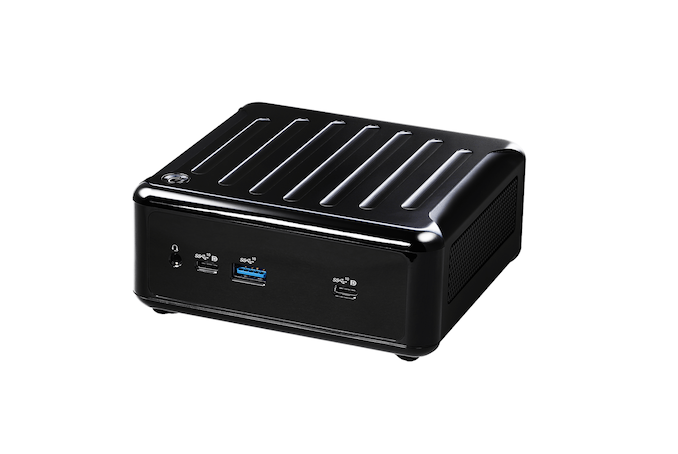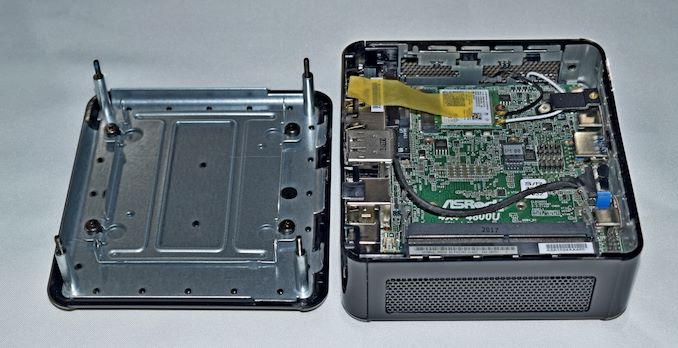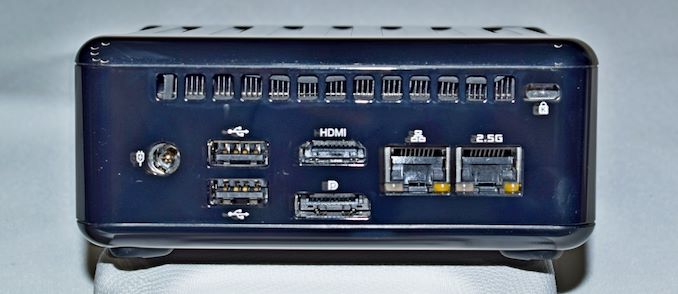ASRock Brings Zen 2 NUC : 4X4 BOX-4800U Renoir Mini-PC Reviewed
by Ganesh T S on November 25, 2020 11:00 AM EST
AMD-based ultra-compact form-factor (UCFF) systems are slowly gaining market acceptance, with the Zen architecture slowly catching up with Intel on both the performance as well as power consumption front. AMD's latest and greatest has been reserved for the high-end desktop market, with the parts meant for low-power / compact systems appearing a few quarters later. Zen 3-based desktop CPUs were introduced recently. However, Zen 2-based parts with 12-25W TDP (Renoir APUs) have started appearing in compact desktop systems only recently. ASRock Industrial launched the Ryzen 4000U-based 4X4 BOX-4000 series in September. The review below looks at the flagship model - the 4X4 BOX-4800U - and how it compares against the equivalent Comet Lake-U-based Frost Canyon NUC from Intel.
Introduction
The PC market has grown in the last few years, thanks in no small part to ultra-compact form-factor (UCFF) and gaming systems. Intel's NUC line-up has been ruling the roost in the former category. Given AMD's focus on multi-threaded performance and core counts with the first-generation Zen microarchitecture, Zen and Zen+-based Ryzen APUs did not have good enough power efficiency and performance per watt to make a dent in Intel's success in the NUC space. ASRock Industrial did release UCFF systems based on the AMD Ryzen Embedded Processors lineup (we reviewed one such system - the 4X4 BOX-V1000M). While the GPU prowess and multi-threaded performance turned out to be appreciable aspects, the single-threaded performance, power efficiency, and driver issues made it a tough sell against competing Intel-based NUCs. The introduction of Zen 2-based APUs (Renoir) fabricated in TSMC's 7nm process changed the equation by addressing all the aforementioned weak points.
AMD prioritized the delivery of Renoir APUs to the notebook market, with mini-PCs following soon after. ASRock Industrial was again at the forefront. Along with Asus's PN50, they were one of the first to launch systems based on these parts. The 4X4 BOX-4000 series has three different SKUs with CPU core counts of 4 (Ryzen 3 4300U), 6 (Ryzen 5 4500U), and 8 (Ryzen 7 4800U) each. The last one is the flagship, and that is the one we are looking at today.
The 4X4 BOX-4800U has a 104mm x 102mm main-board housed in a 110mm x 117.5mm x 47.85mm plastic chassis. The system matches the Intel NUCs in the footprint department. The board comes with a soldered processor - the Ryzen 7 4800U belonging to the AMD Renoir APU series. It is an octa-core processor with SMT enabled (8C/16T). It can operate with a TDP configurable between 12W and 25W.
ASRock Industrial sampled us a barebones version of the system. In partnership with Patriot Memory, they also provided us with their recommended storage (Patriot P300 PCIe 3.0 x4 NVMe SSD) and memory (Patriot Signature Line 2x32GB DDR4-3200 SODIMM) for usage with the PC.
The specifications of our ASRock 4X4 BOX-4800U review configuration are summarized in the table below.
| ASRock 4X4 BOX-4800U Specifications | |
| Processor | AMD Ryzen 7 4800U Zen 2 (Renoir) 8C/16T, 1.8 - 4.2 GHz TSMC 7nm, 8MB L3, 10 - 25 W (15W) |
| Memory | Patriot Memory PSD432G32002S DDR4 SODIMM 22-22-22-52 @ 3200 MHz 2x32 GB |
| Graphics | AMD Radeon Graphics (Renoir) - Integrated GPU with 8 CUs |
| Disk Drive(s) | Patriot P300 (512 GB; M.2 2280 PCIe 3.0 x4; Kioxia 96L 3D TLC) (Silicon Motion SM2263XT Controller) |
| Networking | Intel Wi-Fi 6 AX200 (2x2 802.11ax - 2400 Mbps) 1x Realtek RTL8111G Gigabit Ethernet Controller 1x Realtek RTL8125 2.5 Gigabit Ethernet Controller |
| Audio | 3.5mm Headphone Jack Capable of 5.1/7.1 digital output with HD audio bitstreaming (HDMI) |
| Miscellaneous I/O Ports | 2x USB 2.0 2x USB 3.2 Gen 2 Type-C 1x USB 3.2 Gen 2 Type-A |
| Operating System | Retail unit is barebones, but we installed Windows 10 Enterprise x64 |
| Pricing (As configured) | $600 (barebones) $878 (as configured) |
| Full Specifications | ASRock Industrial 4X4 BOX-4800U Specifications |
The ASRock Industrial 4X4 BOX-4800U kit doesn't come with any pre-installed OS, but does come with a CD containing the drivers. In any case, we ended up installing the latest drivers downloaded off the product support page. In addition to the main unit, the other components of the package include a 90 W (19V @ 4.74A) adapter, a US power cord, a VESA mount (along with the necessary screws), a driver CD, user's manual and a quick-start guide. Installing the storage and RAM is straightforward - a matter of popping off four screws on the chassis underside and mounting the components in the appropriate slot.
The above gallery shows the package components along with the chassis design and the internal components. The system also includes support for the installation of a 2.5" drive, with a very flexible SATA power / data cable already in place.
In the table below, we have an overview of the various systems that we are comparing the ASRock 4X4 BOX-4800U against. Note that they may not belong to the same market segment. The relevant configuration details of the machines are provided so that readers have an understanding of why some benchmark numbers are skewed for or against the ASRock 4X4 BOX-4800U when we come to those sections.
| Comparative PC Configurations | ||
| Aspect | ASRock 4X4 BOX-4800U | |
| CPU | AMD Ryzen 7 4800U | AMD Ryzen 7 4800U |
| GPU | AMD Renoir (Radeon RX Vega 8 / GCN5) | AMD Renoir (Radeon RX Vega 8 / GCN5) |
| RAM | Patriot Memory PSD432G32002S DDR4 SODIMM 22-22-22-52 @ 3200 MHz 2x32 GB |
Patriot Memory PSD432G32002S DDR4 SODIMM 22-22-22-52 @ 3200 MHz 2x32 GB |
| Storage | Patriot P300 (512 GB; M.2 2280 PCIe 3.0 x4; Kioxia 96L 3D TLC) (Silicon Motion SM2263XT Controller) |
Patriot P300 (512 GB; M.2 2280 PCIe 3.0 x4; Kioxia 96L 3D TLC) (Silicon Motion SM2263XT Controller) |
| Wi-Fi | Intel Wi-Fi 6 AX200 (2x2 802.11ax - 2400 Mbps) |
Intel Wi-Fi 6 AX200 (2x2 802.11ax - 2400 Mbps) |
| Price (in USD, when built) | $600 (barebones) $878 (as configured) |
$600 (barebones) $878 (as configured) |



















53 Comments
View All Comments
philehidiot - Wednesday, November 25, 2020 - link
I've been drinking, it's 1900 and I've only eaten breakfast today so bear with me.I'm just astonished that we're now using 64GB DDR4 to eliminate any chance bottlenecking. My last system had 24GB DDR3 and I'm now on 16GB DDR4 with no memory concerns.
As for *hic* SFF HTPC use, AMD has driver issues. I once said to a guy who deals in GPGPU stuff that "I don't have enough experience in drivers or coding to be able to say whether AMD's drivers are good or bad" and his response was "that's the same problem AMD have". If I'm using a PC for relaxing, having to debug or troubleshoot is not ideal. It's a shame, as noted in the conclusion here, that QA is often done on Intel systems and AMD don't get a look-in. Hopefully, as AMD become profitable and more performant they'll be able to convince people to QA on their hardware as well.
They definitely need to sort out their drivers and assess the OEM support for other hardware. It's a sad fact that, since I dropped Intel for AMD (both CPU and GPU), I've had more crashes in a month than in years of Intel/Nvidia systems. I've lost more time to lost work than when I was using Windows 98 and CTRL+S after every change is back to being automatic.
A few months ago I was trying to get 4K working on Netflix and their website specified only Nvidia card support or Intel iGPU decode support. Their support staff had never heard of the issue and so I went through the codecs supported by AMD and pointed out at least their hardware spec page should mention AMD once??? The guy couldn't help so he took it as a comment to escalate higher.
/ramble. I need crisps.
StevoLincolnite - Wednesday, November 25, 2020 - link
Got a secondary AMD rig that is 10+ years old and stays online for weeks at a time without a crash.Still runs games just fine, the more modern titles that are heavier threaded tend to run much better on the old Phenom 2 x6 and paired up with the Radeon RX 580 is a pretty capable 1080P rig.
Will upgrade it when it's useless.
YB1064 - Wednesday, November 25, 2020 - link
$900 is a bit too rich for my blood.BTW, what happened to the latest RTX 3xxx review? Did you guys give up on it?
Makaveli - Thursday, November 26, 2020 - link
Apparently you didn't get the memo.fcth - Friday, November 27, 2020 - link
No explanation as to the delay (originally it was related to the fires in California, but it sounded like they were past that), but Ryan said a couple days ago that they are still getting caught up: https://twitter.com/RyanSmithAT/status/13317467171...damianrobertjones - Wednesday, November 25, 2020 - link
...and Intel's driver support for Intel Nucs is hardly anything to scream about.dontlistentome - Wednesday, November 25, 2020 - link
Took Intel an age (over a year) to fix the BIOS updater on systems with Bitlocker - would fail to suspend the encryption so you'd be left with a machine that wouldn't boot, with a locked drive. Hope you kept the recovery key somewhere accessible.Samus - Thursday, November 26, 2020 - link
OMG I remember that bug, the worst part was there was no way to clone a drive to upgrade the SSD because you couldn't suspend bitlocker so you had to decrypt the drive which takes hours in some cases. 3-4 hour project just to upgrade an SSD...Yorgos - Thursday, November 26, 2020 - link
It took intel 3 or 4 years to fix the N2230 driver on linux.bananaforscale - Thursday, November 26, 2020 - link
I remember when Atoms first came and the NM10 chipset. It had crap support on Linux (didn't support resolutions beyond 800x600 for a while). Then there's Asus Transformer Book that has Intel hardware that's only supported under 32 bit Windows, so no upgrading to 64 bit (even if it would've been a bit silly in that particular case as it only had 2GB RAM). Linux is right out.